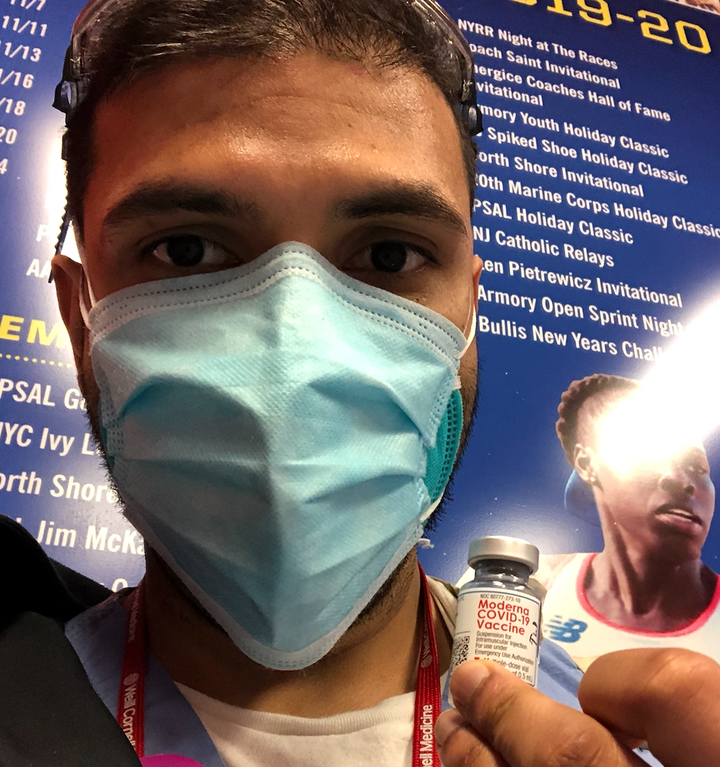Note: All names and identifying details in this essay have been changed to protect the privacy of individuals.
When batches of Covid-19 vaccines first arrived in New York City, health care centres were seeking volunteers to help vaccinate. As a medical student in Manhattan committed to doing anything I could to facilitate the pandemic response, I signed up right away.
What is typically an indoor running track became a makeshift site for Covid-19 vaccines. At 2pm, when I arrived, there was a line of people spilling onto the street: hundreds of them patiently waiting on a pea-green turf, double-checking their proofs of appointments, slightly nervous, their faces only partially visible behind their masks.
I was told volunteers were needed in the basement, an area designated for patients with accessibility challenges. So I went downstairs, dropped off my coat, sanitised my hands, and got set up.
My first patient was Maxine Gold, a retired teacher in her late 60s who traveled all the way from the tip of Long Island to be vaccinated.
“Ms Gold, we’ll be giving you the Moderna vaccine today. Do you have any questions before we get started?” I asked.
No questions at all. She’d been so excited to receive the vaccine that once her appointment had been confirmed, she held a Zoom party with her friends and close family members. Another virtual celebration with caviar and champagne was already on the calendar for that evening.
Dazzling in a black sequinned dress, she told me, “I’ve never wanted something this badly in my life. I’ve even worn my nicest dress to experience this moment.”
We went through a list of questions, checking to see if she had any allergies. Then we discussed some of the side effects of the vaccine: injection site soreness, mild temperature elevation, a general feeling of malaise that should subside within a few days.
Then, it was time for the shot. She wanted it videotaped so that she could send it to her friends and family afterward ― “Especially the ones who are scared, or don’t want to do it or just want to know what it’s all about — you know, like the super hesitant ones,” she said.
When everything was ready to go, a pharmacy technician from an adjacent table came over and held Ms Gold’s phone. Within a matter of seconds, it was all done.
“I’m okay, I’m okay. These are just happy tears,” she cried.
By the time she was leaving our table to walk over to the observation area, where she’d be held for 15 minutes, my next two patients arrived.
Irene Silver and her husband, Robert Boch, both in their early 70s, had traveled over 100 miles from upstate New York to get their vaccines. To avoid the stress of transportation logistics, they had even stayed overnight at a nearby hotel.
“Hi Mr Boch, I’m Tom, a medical student, and I’ll be giving you your vaccine today. Do you have any questions before we get started?” I asked him.
“Actually, yes. I’m just curious, which vaccine am I getting today? The Pfizer one?” he inquired.
“No. We’re giving out the Moderna vaccine at this location. It’s just as effective as the other one,” I replied.
Mr Boch looked disappointed ― a little deflated, even. He turned to his wife and sighed, “I guess we don’t have a choice.”
“Mr Boch, can you help me understand why you prefer the Pfizer vaccine?” I asked.
“I don’t know. I feel like I’ve heard the name Pfizer so many times before, seen them on TV,” he said. “It’s just a brand I’m more familiar with. So, their vaccine just feels better,” he surmised. “Also, didn’t it get approved first? So, I thought maybe it was a more effective vaccine and that’s why the FDA rushed to approve it first.”
I thanked Mr Boch for articulating his concerns and engaged him in a brief conversation on the high efficacies of both vaccines. I also tried to dispel the idea that the vaccine approved first is a better vaccine and explained that approval timelines often depend on numerous factors, including the research and development milestones, the timing of clinical trial endpoints, availability of resources from contract research organisations and the number of participants recruited per study.
While I wasn’t able to completely put his mind at ease, he was still elated to receive the Moderna vaccine. “This feels like a dream come true,” he said.

When it was Ms Silver’s turn, she seemed to have a similar preference for the Pfizer vaccine.
“You know, in my mind, Pfizer versus Moderna feels like comparing Google to Yahoo,” she said. “They are both good, and give very similar results, but Google just feels better to me for whatever reason. In the same way, the Pfizer vaccine just feels like it would be better, but I don’t have a good reason.”
But at the end of the day, Ms Silver was beyond overjoyed to receive “a vaccine, any vaccine” and posed for a photo as she received her shot.
Dozens of people came by my table that day to receive their vaccines. And while some people were understandably nervous — more so about discomfort from the syringe than the composition of the vaccine itself — positive energy pervaded the site.
Some family members brought celebratory balloons, painted on plastic the words “You did it!” Others brought bouquets of wild chrysanthemums and lilacs. So many people were dressed up for the occasion — there were silk scarves and berets and colorful suspenders. And every now and then, thunderous applause would break out in some part of the room.
Then finally, toward the end of my four-hour shift, Ms. Manuela Mendez arrived in a wheelchair wearing a gorgeous huipil, a traditional garment worn by Indigenous women from central Mexico.
She only spoke Spanish, which I don’t speak, so I called the interpreter hotline to get her appointment started.
“How are you doing today, Ms Mendez?”
“Estoy tan nerviosa (I’m so nervous),” she said. “He estado pensando en esto todo el día (I’ve been thinking about this all day).”
Seeing her so visibly anxious, I asked one of the Spanish-speaking patient navigators to come over and help us.
I noted her food and medication allergies and explained what to expect in terms of typical side effects. “Do you have any questions for me at this time, Ms. Mendez?”
She did. She told me she had an immuno-compromising condition and didn’t know if the vaccine would exacerbate it. I could’ve answered her question ― as of now, we don’t have any evidence to suggest that ― but instead, I asked a Spanish-speaking attending physician to talk to her and allay her fears.
Then, an unexpected thing happened. As I drew 0.5ml of the Moderna vaccine into a VanishPoint® syringe, Ms. Mendez started crying. The attending physician, patient navigator and I tried to console her, focusing on the fact that it would merely feel like a little pinch, not that different from a flu shot, and that it would be over in a matter of seconds. As her tears continued to flow and she started appearing flushed, we decided to give her the option of coming back another time if she preferred.
But ultimately, it wasn’t the syringe that was the issue. She was just overwhelmed — overwhelmed with a whole rollercoaster of emotions because “mi hijo murió de Covid-19 (my son died of Covid-19),” she said.
I felt a gut-wrenching sense of sorrow to hear of her son’s death and offered my deepest condolences. But I also made a concerted effort to thank her for making the time to get the vaccine.
Reflecting on the lived experiences of all the people I vaccinated that day, something within me has shifted. In a way, I feel like I can better empathise with patients’ feelings of survivor’s guilt, contextualise people’s beliefs (and certain misperceptions) about the various COVID-19 vaccines, and most importantly, partake in a public health ritual that can perhaps help people “get a fresh start to this crazy decade,” as one patient put it.
As a nation, we have a long way to go with optimising the vaccine rollout programs. And with the sudden rise in SARS-CoV-2 mutants, we might even have to further tweak the composition of vaccines. But despite all the imperfections and chaos, the challenges of logistics, and unanticipated constraints, it is important to remember that a sense of positivity and gratitude are not lost among people receiving the vaccine.
Many patients suffered personal tragedies — losing friends and family to this treacherous virus — while others succumbed to bouts of depression catalysed by lockdowns and social isolation. But hope is what keeps some people going, and a little acknowledgment of what we’re doing right doesn’t hurt.
As a patient told me before he left the room, “I’m as excited to get this vaccine as I was to vote fascism out.” We laughed, gave each other air hugs, and promised to see each other in 28 days for the second dose.
And as I cleaned my little bench area and unpacked a wad of gauze for the next patient, I couldn’t help but smile under the creases of my mask.
Lala Tanmoy (Tom) Das is an M.D.-Ph.D. student in the Weill Cornell/Rockefeller University/Memorial Sloan Kettering Tri-Institutional Program. This article first appeared on HuffPost Personal.

